International HR Practices Analysis: A Report on Danone's Strategies
VerifiedAdded on 2020/04/21
|12
|3331
|87
Report
AI Summary
This report provides an in-depth analysis of Danone's international HR practices, focusing on market entry strategies and the challenges of operating in a cross-cultural environment. It begins by outlining the challenges associated with global market entry, including organizational structure, legal procedures, and foreign exchange. The report then examines various international development strategies, specifically for the UK and Canada, discussing the benefits and limitations of each. Furthermore, it explores the impact of these strategies on HR functions, such as inventory management, organizational policies, and staffing. The report also delves into cross-cultural training and the importance of understanding cultural differences, using Hofstede's cultural dimensions to analyze the UK. Finally, it addresses the concept of cultural shock and offers conclusions and recommendations for effective international HR management. This report is a valuable resource for understanding the complexities of international business and HR management within a multinational corporation like Danone.
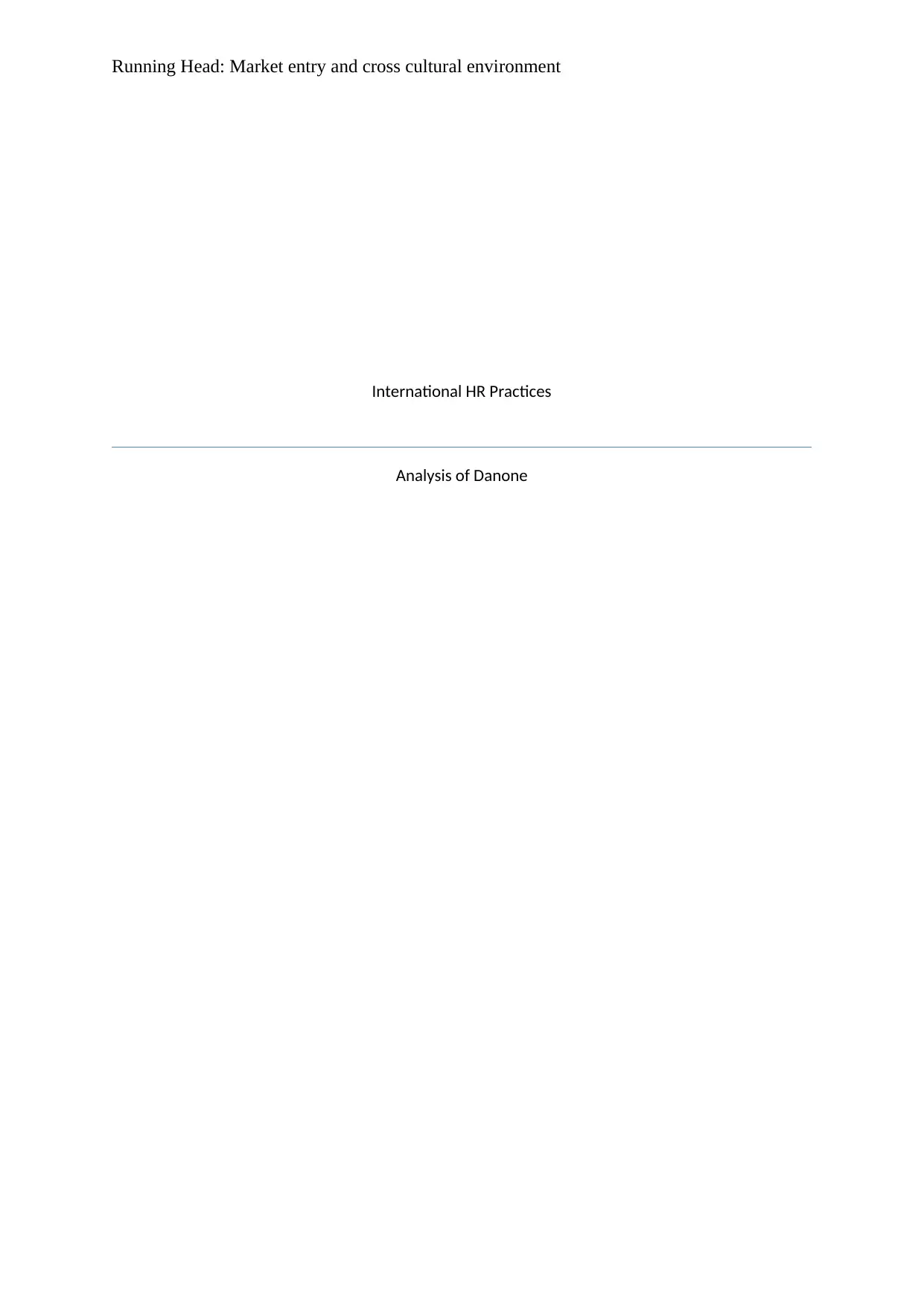
Running Head: Market entry and cross cultural environment
International HR Practices
Analysis of Danone
International HR Practices
Analysis of Danone
Paraphrase This Document
Need a fresh take? Get an instant paraphrase of this document with our AI Paraphraser
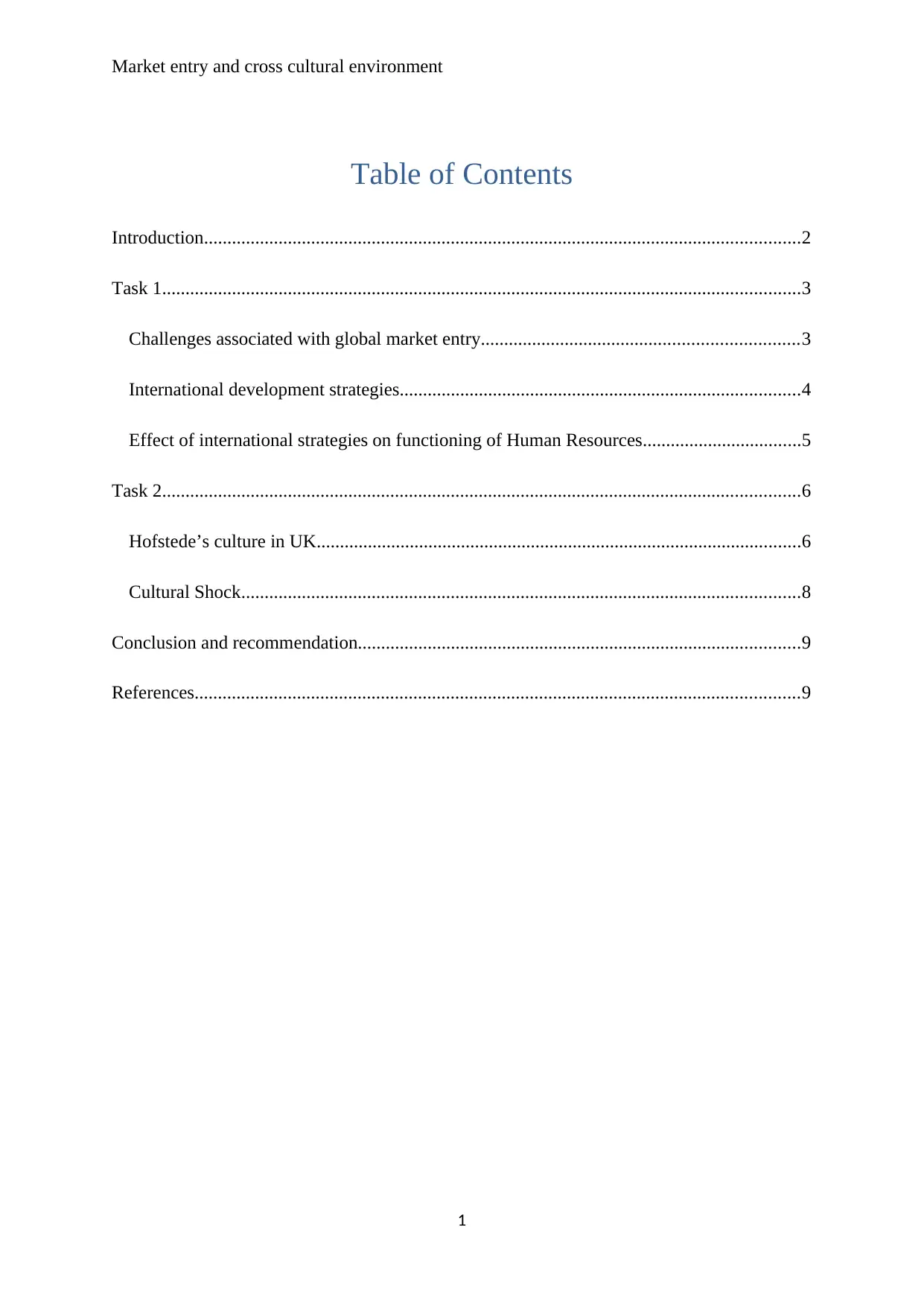
Market entry and cross cultural environment
Table of Contents
Introduction................................................................................................................................2
Task 1.........................................................................................................................................3
Challenges associated with global market entry....................................................................3
International development strategies......................................................................................4
Effect of international strategies on functioning of Human Resources..................................5
Task 2.........................................................................................................................................6
Hofstede’s culture in UK........................................................................................................6
Cultural Shock........................................................................................................................8
Conclusion and recommendation...............................................................................................9
References..................................................................................................................................9
1
Table of Contents
Introduction................................................................................................................................2
Task 1.........................................................................................................................................3
Challenges associated with global market entry....................................................................3
International development strategies......................................................................................4
Effect of international strategies on functioning of Human Resources..................................5
Task 2.........................................................................................................................................6
Hofstede’s culture in UK........................................................................................................6
Cultural Shock........................................................................................................................8
Conclusion and recommendation...............................................................................................9
References..................................................................................................................................9
1
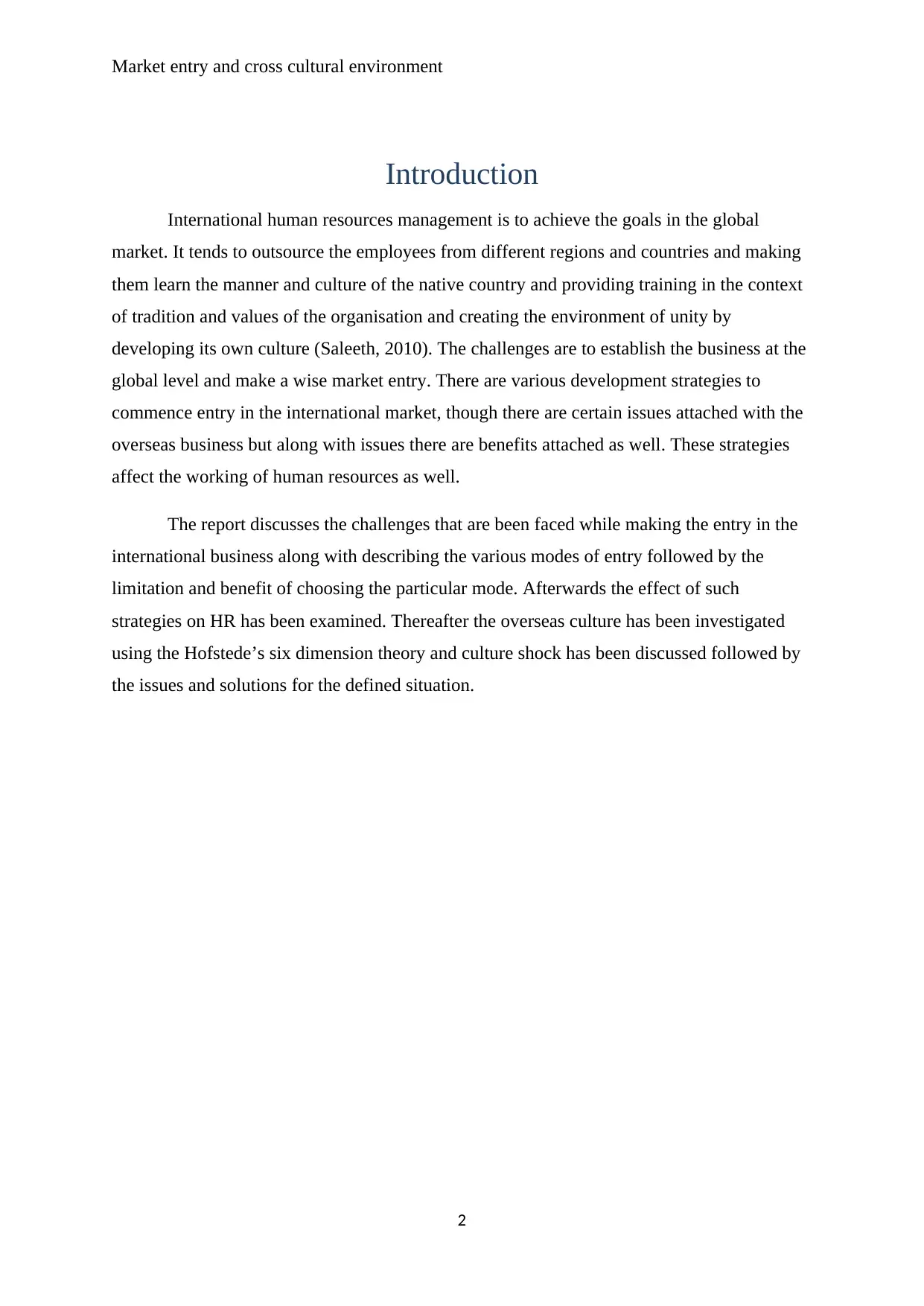
Market entry and cross cultural environment
Introduction
International human resources management is to achieve the goals in the global
market. It tends to outsource the employees from different regions and countries and making
them learn the manner and culture of the native country and providing training in the context
of tradition and values of the organisation and creating the environment of unity by
developing its own culture (Saleeth, 2010). The challenges are to establish the business at the
global level and make a wise market entry. There are various development strategies to
commence entry in the international market, though there are certain issues attached with the
overseas business but along with issues there are benefits attached as well. These strategies
affect the working of human resources as well.
The report discusses the challenges that are been faced while making the entry in the
international business along with describing the various modes of entry followed by the
limitation and benefit of choosing the particular mode. Afterwards the effect of such
strategies on HR has been examined. Thereafter the overseas culture has been investigated
using the Hofstede’s six dimension theory and culture shock has been discussed followed by
the issues and solutions for the defined situation.
2
Introduction
International human resources management is to achieve the goals in the global
market. It tends to outsource the employees from different regions and countries and making
them learn the manner and culture of the native country and providing training in the context
of tradition and values of the organisation and creating the environment of unity by
developing its own culture (Saleeth, 2010). The challenges are to establish the business at the
global level and make a wise market entry. There are various development strategies to
commence entry in the international market, though there are certain issues attached with the
overseas business but along with issues there are benefits attached as well. These strategies
affect the working of human resources as well.
The report discusses the challenges that are been faced while making the entry in the
international business along with describing the various modes of entry followed by the
limitation and benefit of choosing the particular mode. Afterwards the effect of such
strategies on HR has been examined. Thereafter the overseas culture has been investigated
using the Hofstede’s six dimension theory and culture shock has been discussed followed by
the issues and solutions for the defined situation.
2
⊘ This is a preview!⊘
Do you want full access?
Subscribe today to unlock all pages.

Trusted by 1+ million students worldwide
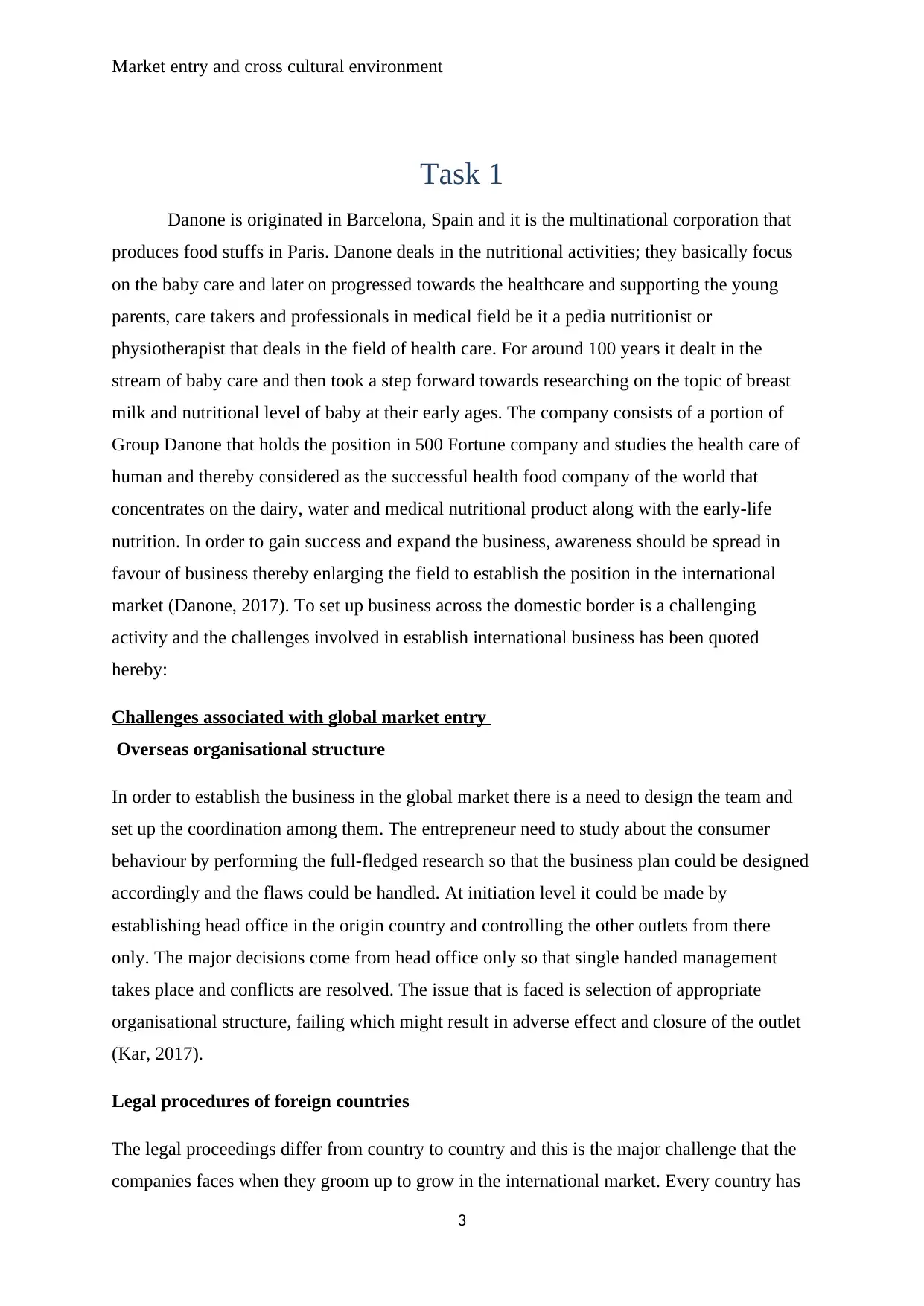
Market entry and cross cultural environment
Task 1
Danone is originated in Barcelona, Spain and it is the multinational corporation that
produces food stuffs in Paris. Danone deals in the nutritional activities; they basically focus
on the baby care and later on progressed towards the healthcare and supporting the young
parents, care takers and professionals in medical field be it a pedia nutritionist or
physiotherapist that deals in the field of health care. For around 100 years it dealt in the
stream of baby care and then took a step forward towards researching on the topic of breast
milk and nutritional level of baby at their early ages. The company consists of a portion of
Group Danone that holds the position in 500 Fortune company and studies the health care of
human and thereby considered as the successful health food company of the world that
concentrates on the dairy, water and medical nutritional product along with the early-life
nutrition. In order to gain success and expand the business, awareness should be spread in
favour of business thereby enlarging the field to establish the position in the international
market (Danone, 2017). To set up business across the domestic border is a challenging
activity and the challenges involved in establish international business has been quoted
hereby:
Challenges associated with global market entry
Overseas organisational structure
In order to establish the business in the global market there is a need to design the team and
set up the coordination among them. The entrepreneur need to study about the consumer
behaviour by performing the full-fledged research so that the business plan could be designed
accordingly and the flaws could be handled. At initiation level it could be made by
establishing head office in the origin country and controlling the other outlets from there
only. The major decisions come from head office only so that single handed management
takes place and conflicts are resolved. The issue that is faced is selection of appropriate
organisational structure, failing which might result in adverse effect and closure of the outlet
(Kar, 2017).
Legal procedures of foreign countries
The legal proceedings differ from country to country and this is the major challenge that the
companies faces when they groom up to grow in the international market. Every country has
3
Task 1
Danone is originated in Barcelona, Spain and it is the multinational corporation that
produces food stuffs in Paris. Danone deals in the nutritional activities; they basically focus
on the baby care and later on progressed towards the healthcare and supporting the young
parents, care takers and professionals in medical field be it a pedia nutritionist or
physiotherapist that deals in the field of health care. For around 100 years it dealt in the
stream of baby care and then took a step forward towards researching on the topic of breast
milk and nutritional level of baby at their early ages. The company consists of a portion of
Group Danone that holds the position in 500 Fortune company and studies the health care of
human and thereby considered as the successful health food company of the world that
concentrates on the dairy, water and medical nutritional product along with the early-life
nutrition. In order to gain success and expand the business, awareness should be spread in
favour of business thereby enlarging the field to establish the position in the international
market (Danone, 2017). To set up business across the domestic border is a challenging
activity and the challenges involved in establish international business has been quoted
hereby:
Challenges associated with global market entry
Overseas organisational structure
In order to establish the business in the global market there is a need to design the team and
set up the coordination among them. The entrepreneur need to study about the consumer
behaviour by performing the full-fledged research so that the business plan could be designed
accordingly and the flaws could be handled. At initiation level it could be made by
establishing head office in the origin country and controlling the other outlets from there
only. The major decisions come from head office only so that single handed management
takes place and conflicts are resolved. The issue that is faced is selection of appropriate
organisational structure, failing which might result in adverse effect and closure of the outlet
(Kar, 2017).
Legal procedures of foreign countries
The legal proceedings differ from country to country and this is the major challenge that the
companies faces when they groom up to grow in the international market. Every country has
3
Paraphrase This Document
Need a fresh take? Get an instant paraphrase of this document with our AI Paraphraser
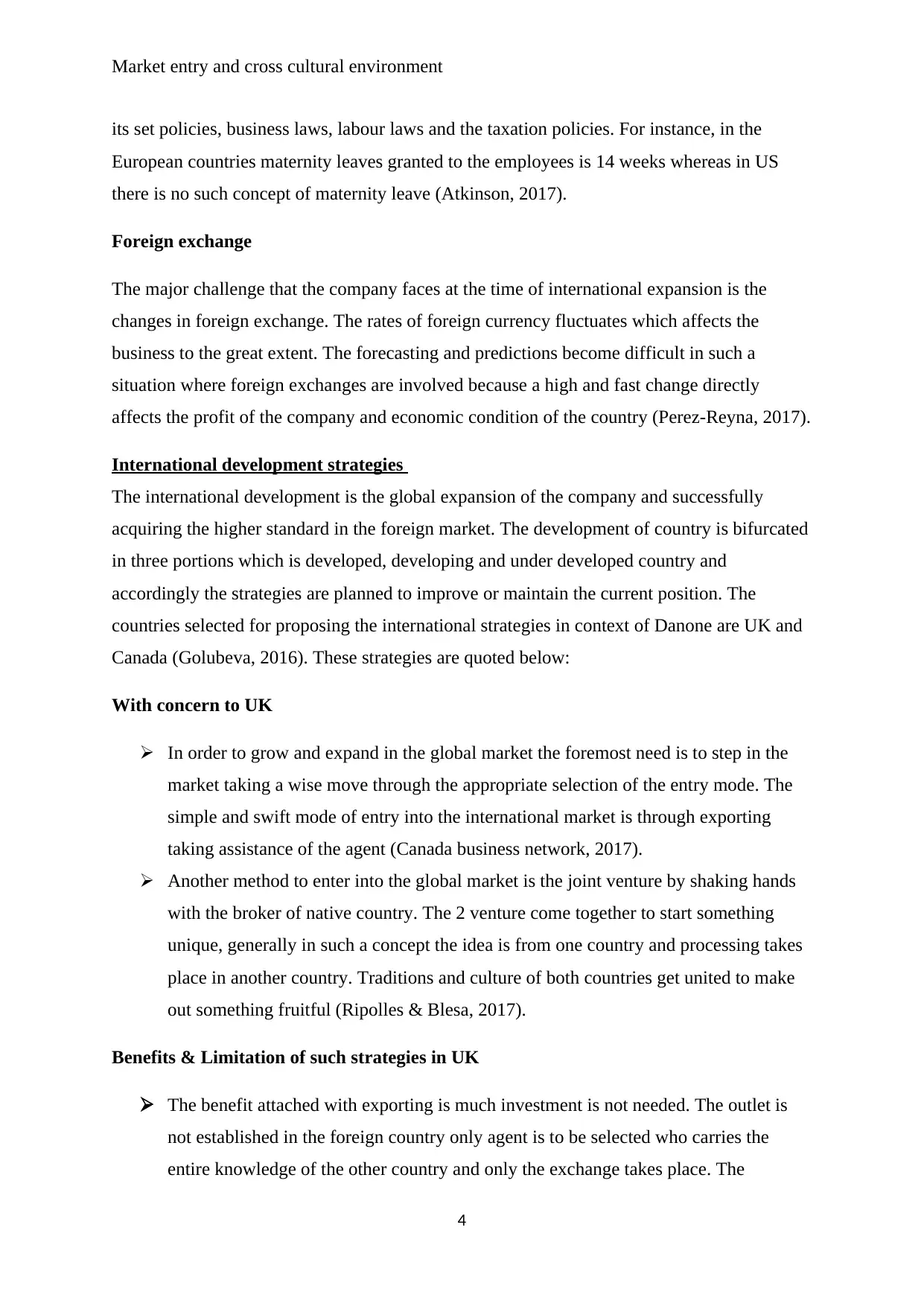
Market entry and cross cultural environment
its set policies, business laws, labour laws and the taxation policies. For instance, in the
European countries maternity leaves granted to the employees is 14 weeks whereas in US
there is no such concept of maternity leave (Atkinson, 2017).
Foreign exchange
The major challenge that the company faces at the time of international expansion is the
changes in foreign exchange. The rates of foreign currency fluctuates which affects the
business to the great extent. The forecasting and predictions become difficult in such a
situation where foreign exchanges are involved because a high and fast change directly
affects the profit of the company and economic condition of the country (Perez-Reyna, 2017).
International development strategies
The international development is the global expansion of the company and successfully
acquiring the higher standard in the foreign market. The development of country is bifurcated
in three portions which is developed, developing and under developed country and
accordingly the strategies are planned to improve or maintain the current position. The
countries selected for proposing the international strategies in context of Danone are UK and
Canada (Golubeva, 2016). These strategies are quoted below:
With concern to UK
In order to grow and expand in the global market the foremost need is to step in the
market taking a wise move through the appropriate selection of the entry mode. The
simple and swift mode of entry into the international market is through exporting
taking assistance of the agent (Canada business network, 2017).
Another method to enter into the global market is the joint venture by shaking hands
with the broker of native country. The 2 venture come together to start something
unique, generally in such a concept the idea is from one country and processing takes
place in another country. Traditions and culture of both countries get united to make
out something fruitful (Ripolles & Blesa, 2017).
Benefits & Limitation of such strategies in UK
The benefit attached with exporting is much investment is not needed. The outlet is
not established in the foreign country only agent is to be selected who carries the
entire knowledge of the other country and only the exchange takes place. The
4
its set policies, business laws, labour laws and the taxation policies. For instance, in the
European countries maternity leaves granted to the employees is 14 weeks whereas in US
there is no such concept of maternity leave (Atkinson, 2017).
Foreign exchange
The major challenge that the company faces at the time of international expansion is the
changes in foreign exchange. The rates of foreign currency fluctuates which affects the
business to the great extent. The forecasting and predictions become difficult in such a
situation where foreign exchanges are involved because a high and fast change directly
affects the profit of the company and economic condition of the country (Perez-Reyna, 2017).
International development strategies
The international development is the global expansion of the company and successfully
acquiring the higher standard in the foreign market. The development of country is bifurcated
in three portions which is developed, developing and under developed country and
accordingly the strategies are planned to improve or maintain the current position. The
countries selected for proposing the international strategies in context of Danone are UK and
Canada (Golubeva, 2016). These strategies are quoted below:
With concern to UK
In order to grow and expand in the global market the foremost need is to step in the
market taking a wise move through the appropriate selection of the entry mode. The
simple and swift mode of entry into the international market is through exporting
taking assistance of the agent (Canada business network, 2017).
Another method to enter into the global market is the joint venture by shaking hands
with the broker of native country. The 2 venture come together to start something
unique, generally in such a concept the idea is from one country and processing takes
place in another country. Traditions and culture of both countries get united to make
out something fruitful (Ripolles & Blesa, 2017).
Benefits & Limitation of such strategies in UK
The benefit attached with exporting is much investment is not needed. The outlet is
not established in the foreign country only agent is to be selected who carries the
entire knowledge of the other country and only the exchange takes place. The
4
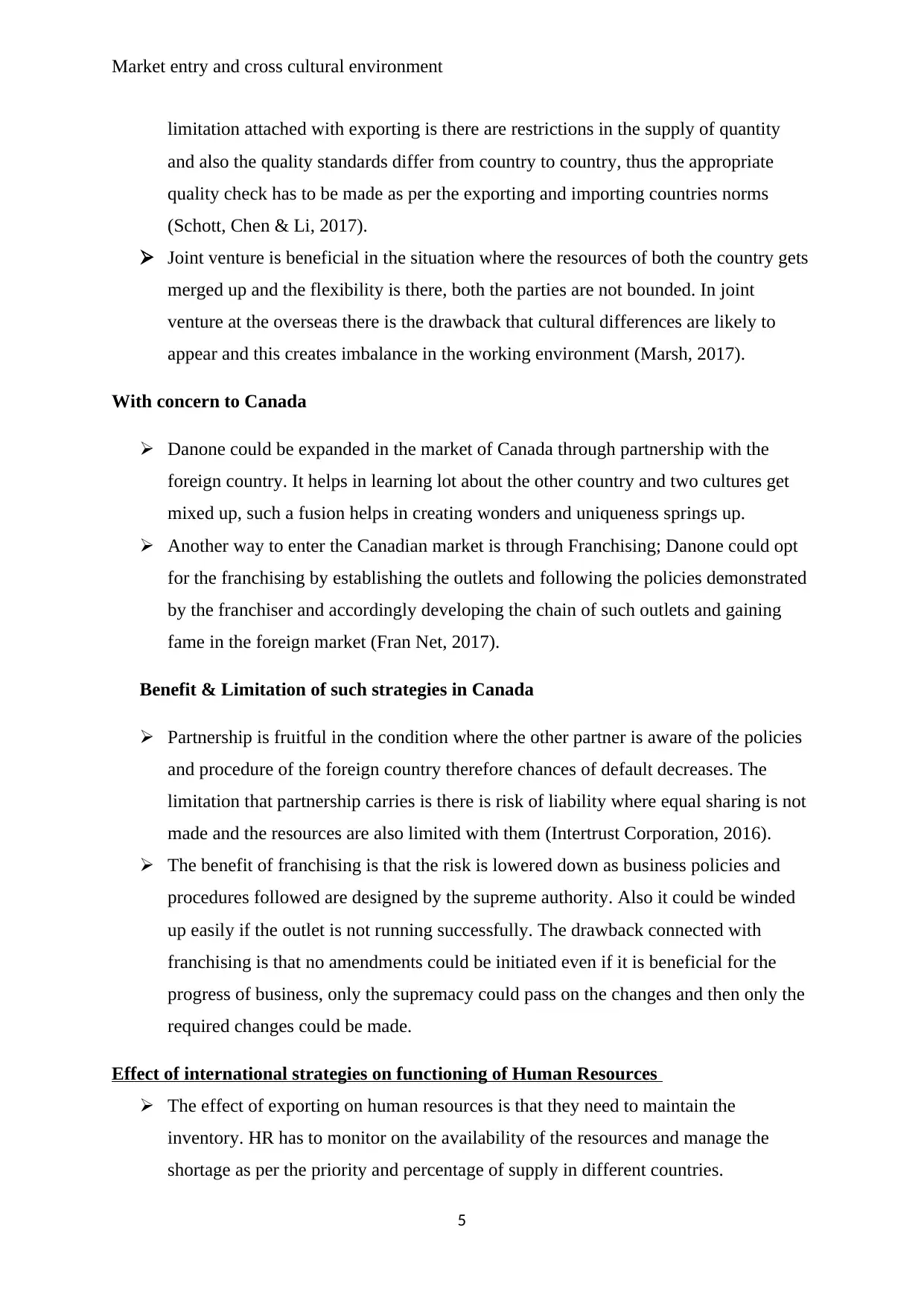
Market entry and cross cultural environment
limitation attached with exporting is there are restrictions in the supply of quantity
and also the quality standards differ from country to country, thus the appropriate
quality check has to be made as per the exporting and importing countries norms
(Schott, Chen & Li, 2017).
Joint venture is beneficial in the situation where the resources of both the country gets
merged up and the flexibility is there, both the parties are not bounded. In joint
venture at the overseas there is the drawback that cultural differences are likely to
appear and this creates imbalance in the working environment (Marsh, 2017).
With concern to Canada
Danone could be expanded in the market of Canada through partnership with the
foreign country. It helps in learning lot about the other country and two cultures get
mixed up, such a fusion helps in creating wonders and uniqueness springs up.
Another way to enter the Canadian market is through Franchising; Danone could opt
for the franchising by establishing the outlets and following the policies demonstrated
by the franchiser and accordingly developing the chain of such outlets and gaining
fame in the foreign market (Fran Net, 2017).
Benefit & Limitation of such strategies in Canada
Partnership is fruitful in the condition where the other partner is aware of the policies
and procedure of the foreign country therefore chances of default decreases. The
limitation that partnership carries is there is risk of liability where equal sharing is not
made and the resources are also limited with them (Intertrust Corporation, 2016).
The benefit of franchising is that the risk is lowered down as business policies and
procedures followed are designed by the supreme authority. Also it could be winded
up easily if the outlet is not running successfully. The drawback connected with
franchising is that no amendments could be initiated even if it is beneficial for the
progress of business, only the supremacy could pass on the changes and then only the
required changes could be made.
Effect of international strategies on functioning of Human Resources
The effect of exporting on human resources is that they need to maintain the
inventory. HR has to monitor on the availability of the resources and manage the
shortage as per the priority and percentage of supply in different countries.
5
limitation attached with exporting is there are restrictions in the supply of quantity
and also the quality standards differ from country to country, thus the appropriate
quality check has to be made as per the exporting and importing countries norms
(Schott, Chen & Li, 2017).
Joint venture is beneficial in the situation where the resources of both the country gets
merged up and the flexibility is there, both the parties are not bounded. In joint
venture at the overseas there is the drawback that cultural differences are likely to
appear and this creates imbalance in the working environment (Marsh, 2017).
With concern to Canada
Danone could be expanded in the market of Canada through partnership with the
foreign country. It helps in learning lot about the other country and two cultures get
mixed up, such a fusion helps in creating wonders and uniqueness springs up.
Another way to enter the Canadian market is through Franchising; Danone could opt
for the franchising by establishing the outlets and following the policies demonstrated
by the franchiser and accordingly developing the chain of such outlets and gaining
fame in the foreign market (Fran Net, 2017).
Benefit & Limitation of such strategies in Canada
Partnership is fruitful in the condition where the other partner is aware of the policies
and procedure of the foreign country therefore chances of default decreases. The
limitation that partnership carries is there is risk of liability where equal sharing is not
made and the resources are also limited with them (Intertrust Corporation, 2016).
The benefit of franchising is that the risk is lowered down as business policies and
procedures followed are designed by the supreme authority. Also it could be winded
up easily if the outlet is not running successfully. The drawback connected with
franchising is that no amendments could be initiated even if it is beneficial for the
progress of business, only the supremacy could pass on the changes and then only the
required changes could be made.
Effect of international strategies on functioning of Human Resources
The effect of exporting on human resources is that they need to maintain the
inventory. HR has to monitor on the availability of the resources and manage the
shortage as per the priority and percentage of supply in different countries.
5
⊘ This is a preview!⊘
Do you want full access?
Subscribe today to unlock all pages.

Trusted by 1+ million students worldwide
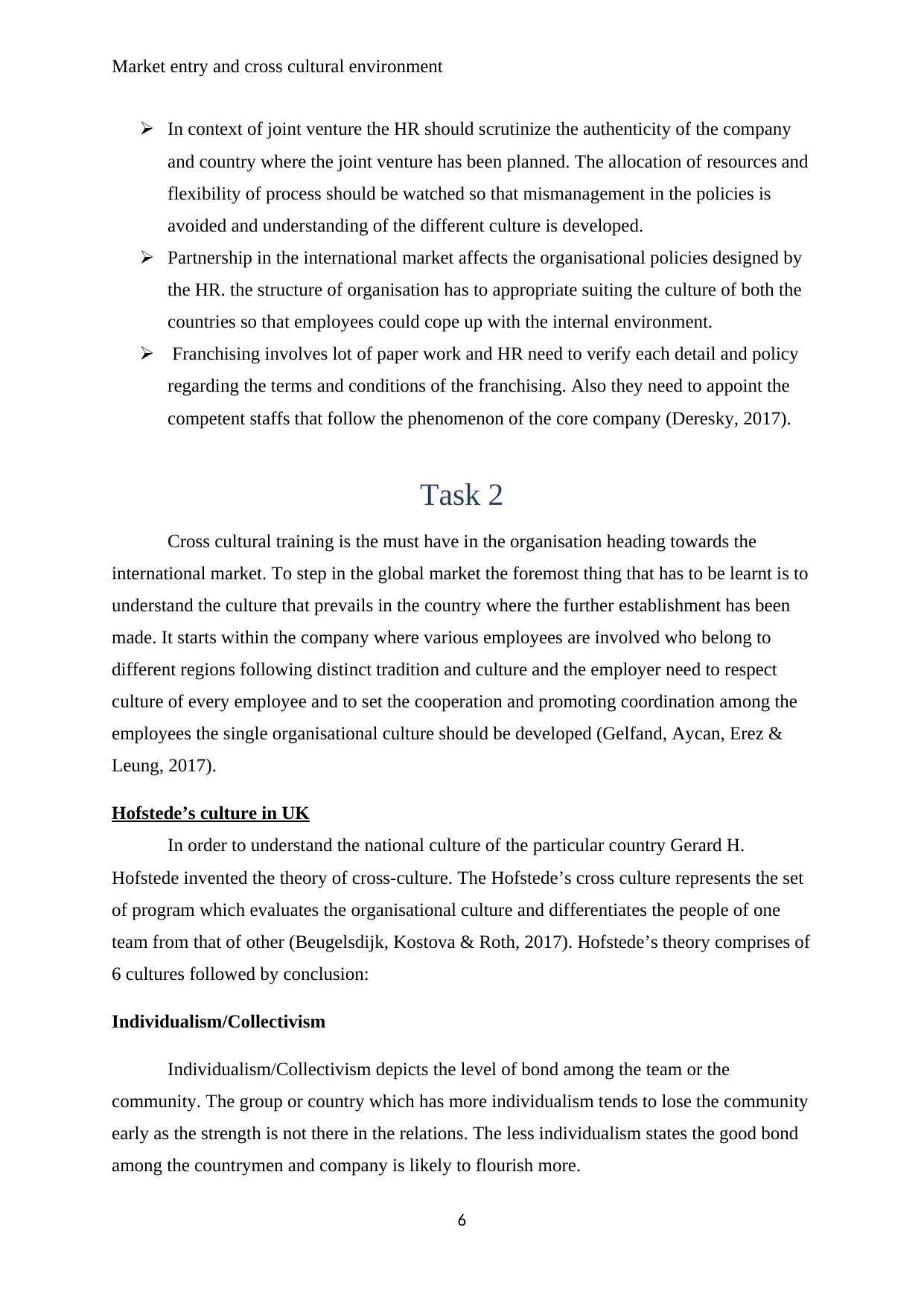
Market entry and cross cultural environment
In context of joint venture the HR should scrutinize the authenticity of the company
and country where the joint venture has been planned. The allocation of resources and
flexibility of process should be watched so that mismanagement in the policies is
avoided and understanding of the different culture is developed.
Partnership in the international market affects the organisational policies designed by
the HR. the structure of organisation has to appropriate suiting the culture of both the
countries so that employees could cope up with the internal environment.
Franchising involves lot of paper work and HR need to verify each detail and policy
regarding the terms and conditions of the franchising. Also they need to appoint the
competent staffs that follow the phenomenon of the core company (Deresky, 2017).
Task 2
Cross cultural training is the must have in the organisation heading towards the
international market. To step in the global market the foremost thing that has to be learnt is to
understand the culture that prevails in the country where the further establishment has been
made. It starts within the company where various employees are involved who belong to
different regions following distinct tradition and culture and the employer need to respect
culture of every employee and to set the cooperation and promoting coordination among the
employees the single organisational culture should be developed (Gelfand, Aycan, Erez &
Leung, 2017).
Hofstede’s culture in UK
In order to understand the national culture of the particular country Gerard H.
Hofstede invented the theory of cross-culture. The Hofstede’s cross culture represents the set
of program which evaluates the organisational culture and differentiates the people of one
team from that of other (Beugelsdijk, Kostova & Roth, 2017). Hofstede’s theory comprises of
6 cultures followed by conclusion:
Individualism/Collectivism
Individualism/Collectivism depicts the level of bond among the team or the
community. The group or country which has more individualism tends to lose the community
early as the strength is not there in the relations. The less individualism states the good bond
among the countrymen and company is likely to flourish more.
6
In context of joint venture the HR should scrutinize the authenticity of the company
and country where the joint venture has been planned. The allocation of resources and
flexibility of process should be watched so that mismanagement in the policies is
avoided and understanding of the different culture is developed.
Partnership in the international market affects the organisational policies designed by
the HR. the structure of organisation has to appropriate suiting the culture of both the
countries so that employees could cope up with the internal environment.
Franchising involves lot of paper work and HR need to verify each detail and policy
regarding the terms and conditions of the franchising. Also they need to appoint the
competent staffs that follow the phenomenon of the core company (Deresky, 2017).
Task 2
Cross cultural training is the must have in the organisation heading towards the
international market. To step in the global market the foremost thing that has to be learnt is to
understand the culture that prevails in the country where the further establishment has been
made. It starts within the company where various employees are involved who belong to
different regions following distinct tradition and culture and the employer need to respect
culture of every employee and to set the cooperation and promoting coordination among the
employees the single organisational culture should be developed (Gelfand, Aycan, Erez &
Leung, 2017).
Hofstede’s culture in UK
In order to understand the national culture of the particular country Gerard H.
Hofstede invented the theory of cross-culture. The Hofstede’s cross culture represents the set
of program which evaluates the organisational culture and differentiates the people of one
team from that of other (Beugelsdijk, Kostova & Roth, 2017). Hofstede’s theory comprises of
6 cultures followed by conclusion:
Individualism/Collectivism
Individualism/Collectivism depicts the level of bond among the team or the
community. The group or country which has more individualism tends to lose the community
early as the strength is not there in the relations. The less individualism states the good bond
among the countrymen and company is likely to flourish more.
6
Paraphrase This Document
Need a fresh take? Get an instant paraphrase of this document with our AI Paraphraser
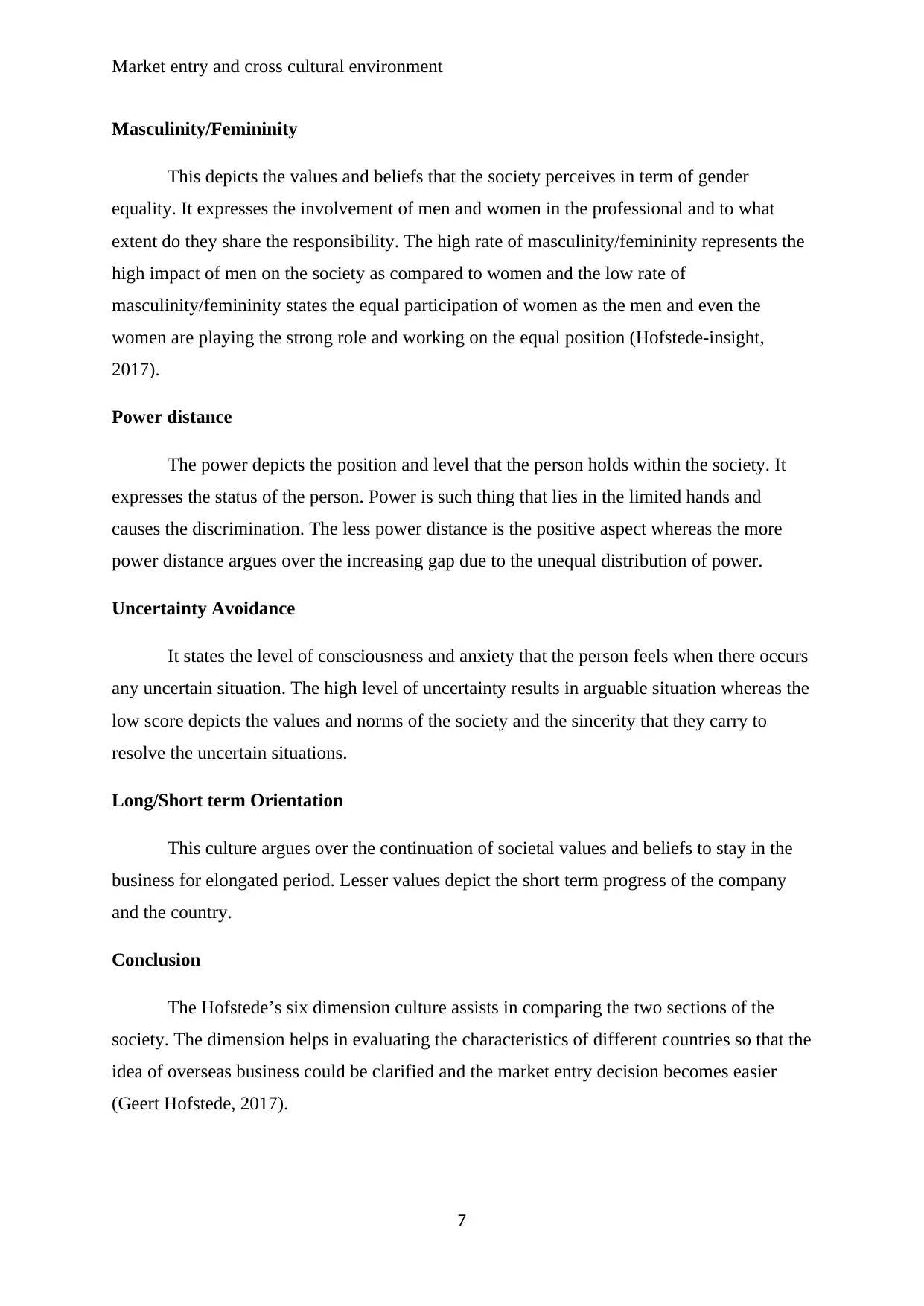
Market entry and cross cultural environment
Masculinity/Femininity
This depicts the values and beliefs that the society perceives in term of gender
equality. It expresses the involvement of men and women in the professional and to what
extent do they share the responsibility. The high rate of masculinity/femininity represents the
high impact of men on the society as compared to women and the low rate of
masculinity/femininity states the equal participation of women as the men and even the
women are playing the strong role and working on the equal position (Hofstede-insight,
2017).
Power distance
The power depicts the position and level that the person holds within the society. It
expresses the status of the person. Power is such thing that lies in the limited hands and
causes the discrimination. The less power distance is the positive aspect whereas the more
power distance argues over the increasing gap due to the unequal distribution of power.
Uncertainty Avoidance
It states the level of consciousness and anxiety that the person feels when there occurs
any uncertain situation. The high level of uncertainty results in arguable situation whereas the
low score depicts the values and norms of the society and the sincerity that they carry to
resolve the uncertain situations.
Long/Short term Orientation
This culture argues over the continuation of societal values and beliefs to stay in the
business for elongated period. Lesser values depict the short term progress of the company
and the country.
Conclusion
The Hofstede’s six dimension culture assists in comparing the two sections of the
society. The dimension helps in evaluating the characteristics of different countries so that the
idea of overseas business could be clarified and the market entry decision becomes easier
(Geert Hofstede, 2017).
7
Masculinity/Femininity
This depicts the values and beliefs that the society perceives in term of gender
equality. It expresses the involvement of men and women in the professional and to what
extent do they share the responsibility. The high rate of masculinity/femininity represents the
high impact of men on the society as compared to women and the low rate of
masculinity/femininity states the equal participation of women as the men and even the
women are playing the strong role and working on the equal position (Hofstede-insight,
2017).
Power distance
The power depicts the position and level that the person holds within the society. It
expresses the status of the person. Power is such thing that lies in the limited hands and
causes the discrimination. The less power distance is the positive aspect whereas the more
power distance argues over the increasing gap due to the unequal distribution of power.
Uncertainty Avoidance
It states the level of consciousness and anxiety that the person feels when there occurs
any uncertain situation. The high level of uncertainty results in arguable situation whereas the
low score depicts the values and norms of the society and the sincerity that they carry to
resolve the uncertain situations.
Long/Short term Orientation
This culture argues over the continuation of societal values and beliefs to stay in the
business for elongated period. Lesser values depict the short term progress of the company
and the country.
Conclusion
The Hofstede’s six dimension culture assists in comparing the two sections of the
society. The dimension helps in evaluating the characteristics of different countries so that the
idea of overseas business could be clarified and the market entry decision becomes easier
(Geert Hofstede, 2017).
7
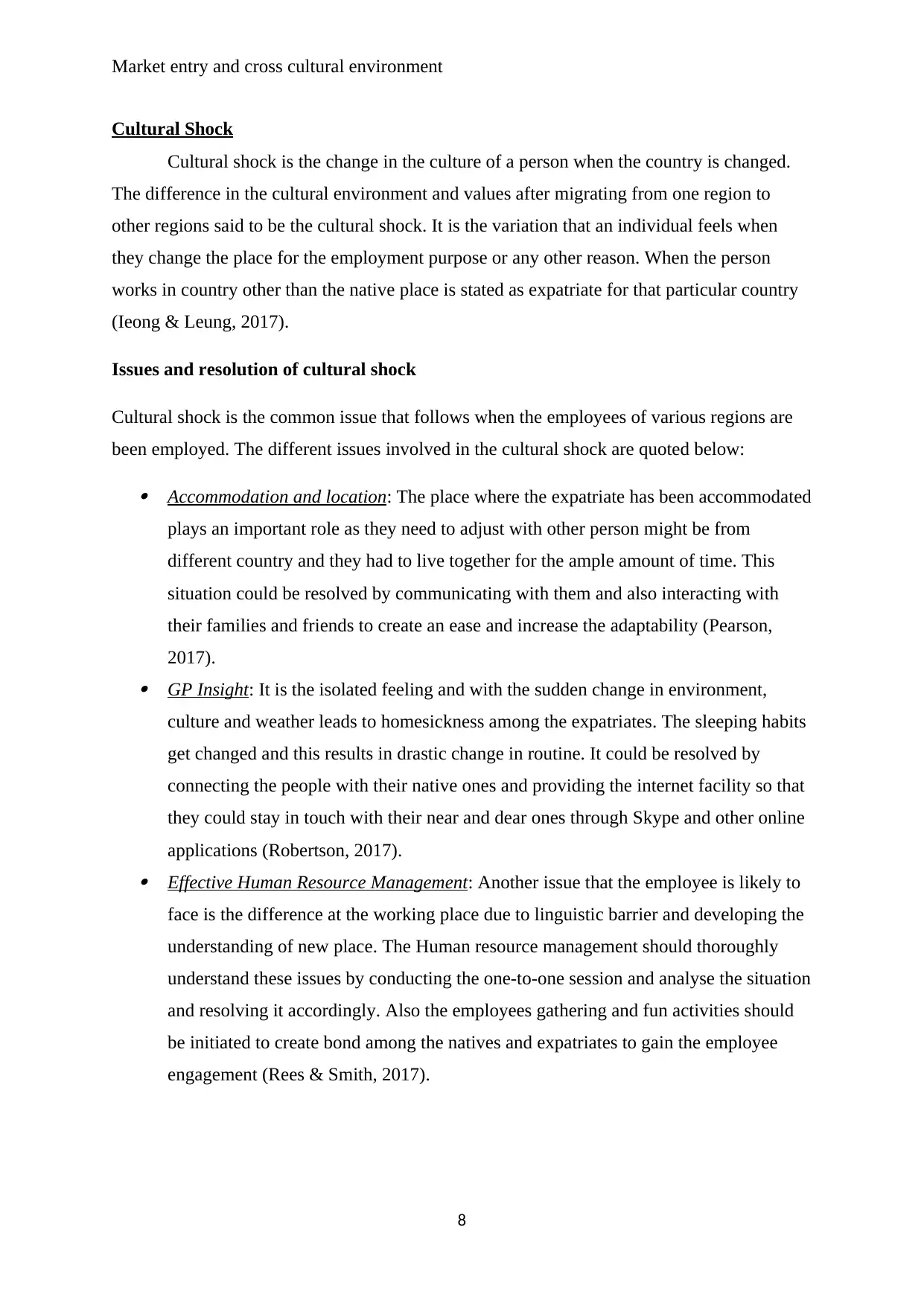
Market entry and cross cultural environment
Cultural Shock
Cultural shock is the change in the culture of a person when the country is changed.
The difference in the cultural environment and values after migrating from one region to
other regions said to be the cultural shock. It is the variation that an individual feels when
they change the place for the employment purpose or any other reason. When the person
works in country other than the native place is stated as expatriate for that particular country
(Ieong & Leung, 2017).
Issues and resolution of cultural shock
Cultural shock is the common issue that follows when the employees of various regions are
been employed. The different issues involved in the cultural shock are quoted below:
Accommodation and location: The place where the expatriate has been accommodated
plays an important role as they need to adjust with other person might be from
different country and they had to live together for the ample amount of time. This
situation could be resolved by communicating with them and also interacting with
their families and friends to create an ease and increase the adaptability (Pearson,
2017). GP Insight: It is the isolated feeling and with the sudden change in environment,
culture and weather leads to homesickness among the expatriates. The sleeping habits
get changed and this results in drastic change in routine. It could be resolved by
connecting the people with their native ones and providing the internet facility so that
they could stay in touch with their near and dear ones through Skype and other online
applications (Robertson, 2017). Effective Human Resource Management: Another issue that the employee is likely to
face is the difference at the working place due to linguistic barrier and developing the
understanding of new place. The Human resource management should thoroughly
understand these issues by conducting the one-to-one session and analyse the situation
and resolving it accordingly. Also the employees gathering and fun activities should
be initiated to create bond among the natives and expatriates to gain the employee
engagement (Rees & Smith, 2017).
8
Cultural Shock
Cultural shock is the change in the culture of a person when the country is changed.
The difference in the cultural environment and values after migrating from one region to
other regions said to be the cultural shock. It is the variation that an individual feels when
they change the place for the employment purpose or any other reason. When the person
works in country other than the native place is stated as expatriate for that particular country
(Ieong & Leung, 2017).
Issues and resolution of cultural shock
Cultural shock is the common issue that follows when the employees of various regions are
been employed. The different issues involved in the cultural shock are quoted below:
Accommodation and location: The place where the expatriate has been accommodated
plays an important role as they need to adjust with other person might be from
different country and they had to live together for the ample amount of time. This
situation could be resolved by communicating with them and also interacting with
their families and friends to create an ease and increase the adaptability (Pearson,
2017). GP Insight: It is the isolated feeling and with the sudden change in environment,
culture and weather leads to homesickness among the expatriates. The sleeping habits
get changed and this results in drastic change in routine. It could be resolved by
connecting the people with their native ones and providing the internet facility so that
they could stay in touch with their near and dear ones through Skype and other online
applications (Robertson, 2017). Effective Human Resource Management: Another issue that the employee is likely to
face is the difference at the working place due to linguistic barrier and developing the
understanding of new place. The Human resource management should thoroughly
understand these issues by conducting the one-to-one session and analyse the situation
and resolving it accordingly. Also the employees gathering and fun activities should
be initiated to create bond among the natives and expatriates to gain the employee
engagement (Rees & Smith, 2017).
8
⊘ This is a preview!⊘
Do you want full access?
Subscribe today to unlock all pages.

Trusted by 1+ million students worldwide
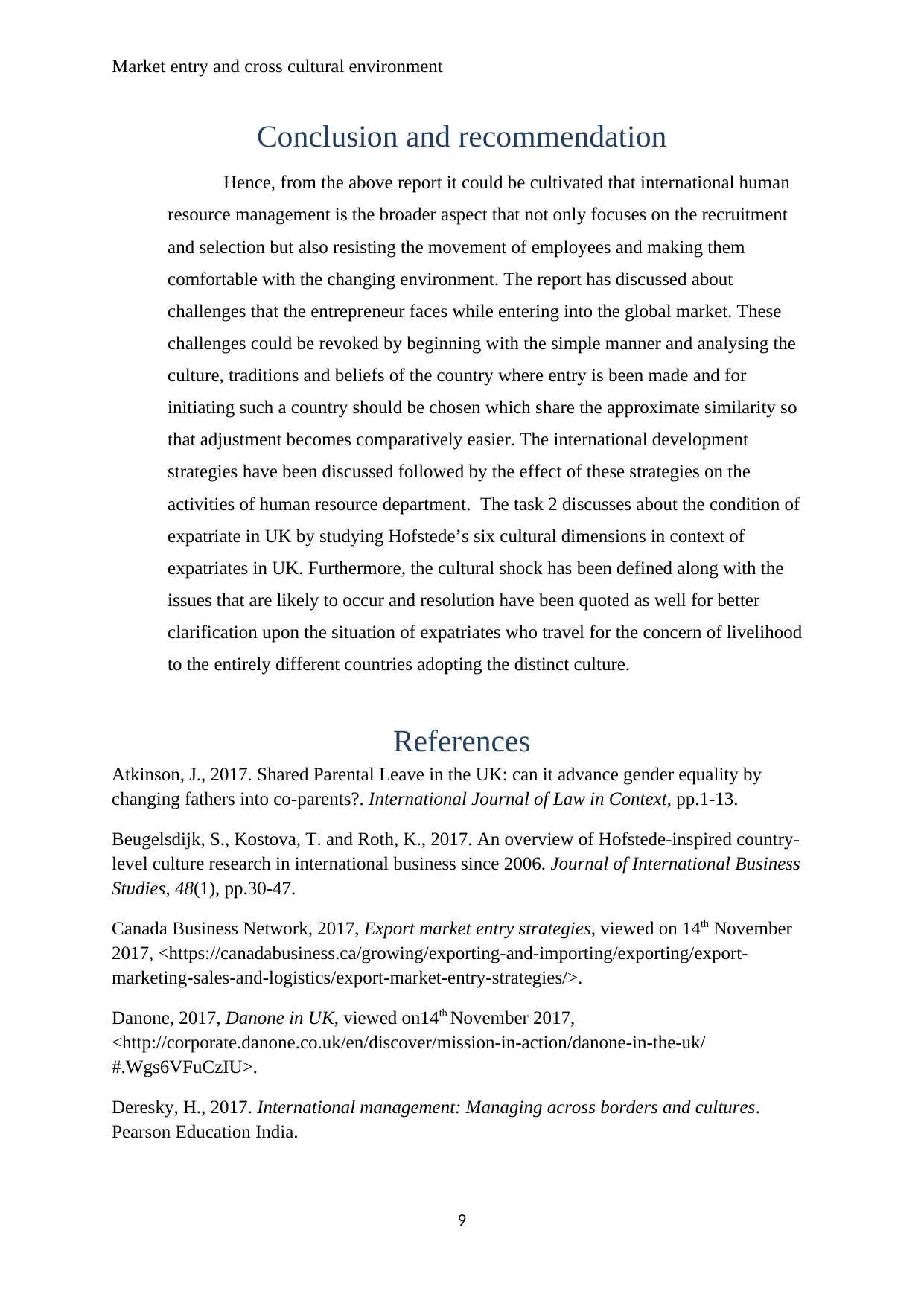
Market entry and cross cultural environment
Conclusion and recommendation
Hence, from the above report it could be cultivated that international human
resource management is the broader aspect that not only focuses on the recruitment
and selection but also resisting the movement of employees and making them
comfortable with the changing environment. The report has discussed about
challenges that the entrepreneur faces while entering into the global market. These
challenges could be revoked by beginning with the simple manner and analysing the
culture, traditions and beliefs of the country where entry is been made and for
initiating such a country should be chosen which share the approximate similarity so
that adjustment becomes comparatively easier. The international development
strategies have been discussed followed by the effect of these strategies on the
activities of human resource department. The task 2 discusses about the condition of
expatriate in UK by studying Hofstede’s six cultural dimensions in context of
expatriates in UK. Furthermore, the cultural shock has been defined along with the
issues that are likely to occur and resolution have been quoted as well for better
clarification upon the situation of expatriates who travel for the concern of livelihood
to the entirely different countries adopting the distinct culture.
References
Atkinson, J., 2017. Shared Parental Leave in the UK: can it advance gender equality by
changing fathers into co-parents?. International Journal of Law in Context, pp.1-13.
Beugelsdijk, S., Kostova, T. and Roth, K., 2017. An overview of Hofstede-inspired country-
level culture research in international business since 2006. Journal of International Business
Studies, 48(1), pp.30-47.
Canada Business Network, 2017, Export market entry strategies, viewed on 14th November
2017, <https://canadabusiness.ca/growing/exporting-and-importing/exporting/export-
marketing-sales-and-logistics/export-market-entry-strategies/>.
Danone, 2017, Danone in UK, viewed on14th November 2017,
<http://corporate.danone.co.uk/en/discover/mission-in-action/danone-in-the-uk/
#.Wgs6VFuCzIU>.
Deresky, H., 2017. International management: Managing across borders and cultures.
Pearson Education India.
9
Conclusion and recommendation
Hence, from the above report it could be cultivated that international human
resource management is the broader aspect that not only focuses on the recruitment
and selection but also resisting the movement of employees and making them
comfortable with the changing environment. The report has discussed about
challenges that the entrepreneur faces while entering into the global market. These
challenges could be revoked by beginning with the simple manner and analysing the
culture, traditions and beliefs of the country where entry is been made and for
initiating such a country should be chosen which share the approximate similarity so
that adjustment becomes comparatively easier. The international development
strategies have been discussed followed by the effect of these strategies on the
activities of human resource department. The task 2 discusses about the condition of
expatriate in UK by studying Hofstede’s six cultural dimensions in context of
expatriates in UK. Furthermore, the cultural shock has been defined along with the
issues that are likely to occur and resolution have been quoted as well for better
clarification upon the situation of expatriates who travel for the concern of livelihood
to the entirely different countries adopting the distinct culture.
References
Atkinson, J., 2017. Shared Parental Leave in the UK: can it advance gender equality by
changing fathers into co-parents?. International Journal of Law in Context, pp.1-13.
Beugelsdijk, S., Kostova, T. and Roth, K., 2017. An overview of Hofstede-inspired country-
level culture research in international business since 2006. Journal of International Business
Studies, 48(1), pp.30-47.
Canada Business Network, 2017, Export market entry strategies, viewed on 14th November
2017, <https://canadabusiness.ca/growing/exporting-and-importing/exporting/export-
marketing-sales-and-logistics/export-market-entry-strategies/>.
Danone, 2017, Danone in UK, viewed on14th November 2017,
<http://corporate.danone.co.uk/en/discover/mission-in-action/danone-in-the-uk/
#.Wgs6VFuCzIU>.
Deresky, H., 2017. International management: Managing across borders and cultures.
Pearson Education India.
9
Paraphrase This Document
Need a fresh take? Get an instant paraphrase of this document with our AI Paraphraser
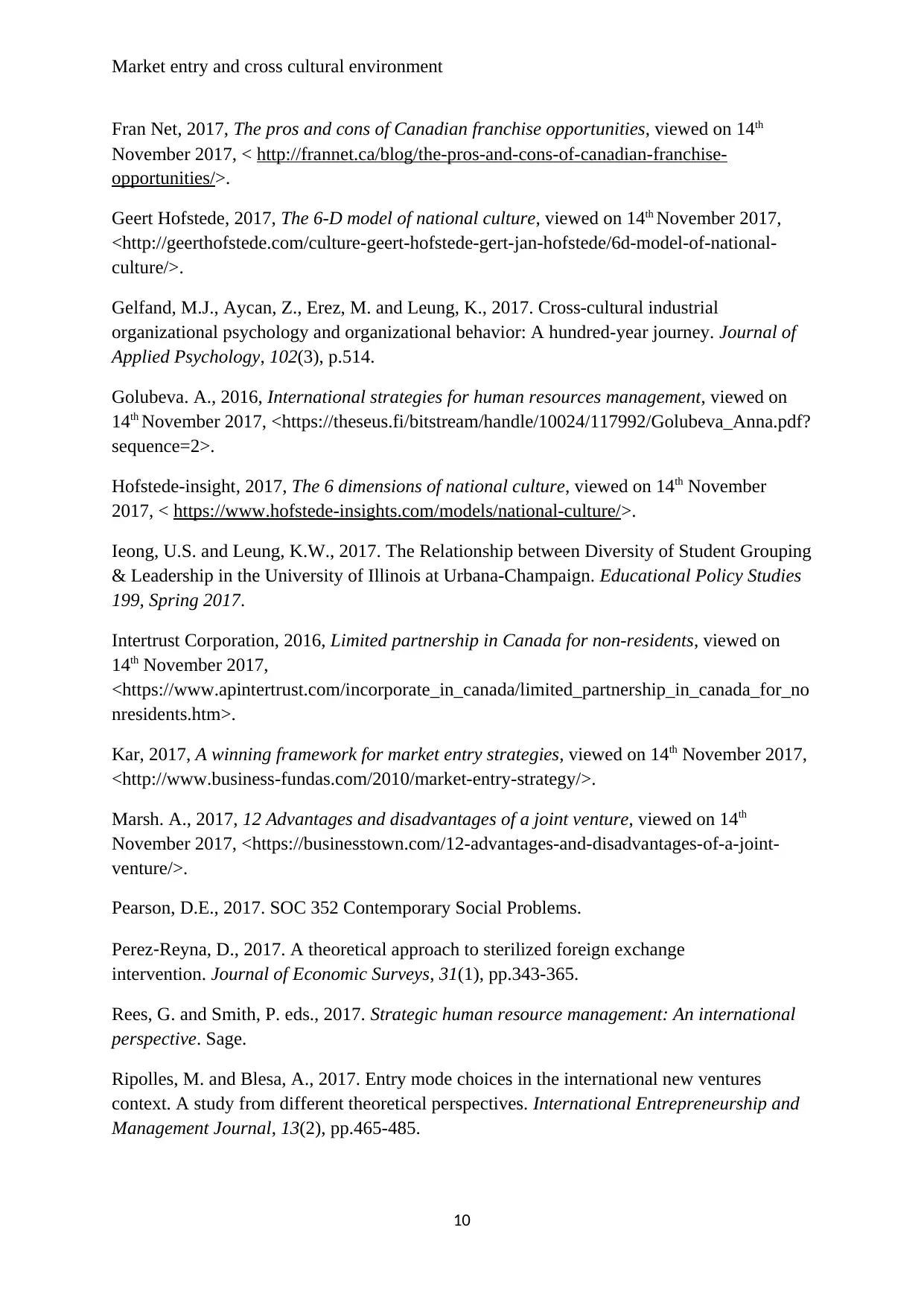
Market entry and cross cultural environment
Fran Net, 2017, The pros and cons of Canadian franchise opportunities, viewed on 14th
November 2017, < http://frannet.ca/blog/the-pros-and-cons-of-canadian-franchise-
opportunities/>.
Geert Hofstede, 2017, The 6-D model of national culture, viewed on 14th November 2017,
<http://geerthofstede.com/culture-geert-hofstede-gert-jan-hofstede/6d-model-of-national-
culture/>.
Gelfand, M.J., Aycan, Z., Erez, M. and Leung, K., 2017. Cross-cultural industrial
organizational psychology and organizational behavior: A hundred-year journey. Journal of
Applied Psychology, 102(3), p.514.
Golubeva. A., 2016, International strategies for human resources management, viewed on
14th November 2017, <https://theseus.fi/bitstream/handle/10024/117992/Golubeva_Anna.pdf?
sequence=2>.
Hofstede-insight, 2017, The 6 dimensions of national culture, viewed on 14th November
2017, < https://www.hofstede-insights.com/models/national-culture/>.
Ieong, U.S. and Leung, K.W., 2017. The Relationship between Diversity of Student Grouping
& Leadership in the University of Illinois at Urbana-Champaign. Educational Policy Studies
199, Spring 2017.
Intertrust Corporation, 2016, Limited partnership in Canada for non-residents, viewed on
14th November 2017,
<https://www.apintertrust.com/incorporate_in_canada/limited_partnership_in_canada_for_no
nresidents.htm>.
Kar, 2017, A winning framework for market entry strategies, viewed on 14th November 2017,
<http://www.business-fundas.com/2010/market-entry-strategy/>.
Marsh. A., 2017, 12 Advantages and disadvantages of a joint venture, viewed on 14th
November 2017, <https://businesstown.com/12-advantages-and-disadvantages-of-a-joint-
venture/>.
Pearson, D.E., 2017. SOC 352 Contemporary Social Problems.
Perez‐Reyna, D., 2017. A theoretical approach to sterilized foreign exchange
intervention. Journal of Economic Surveys, 31(1), pp.343-365.
Rees, G. and Smith, P. eds., 2017. Strategic human resource management: An international
perspective. Sage.
Ripolles, M. and Blesa, A., 2017. Entry mode choices in the international new ventures
context. A study from different theoretical perspectives. International Entrepreneurship and
Management Journal, 13(2), pp.465-485.
10
Fran Net, 2017, The pros and cons of Canadian franchise opportunities, viewed on 14th
November 2017, < http://frannet.ca/blog/the-pros-and-cons-of-canadian-franchise-
opportunities/>.
Geert Hofstede, 2017, The 6-D model of national culture, viewed on 14th November 2017,
<http://geerthofstede.com/culture-geert-hofstede-gert-jan-hofstede/6d-model-of-national-
culture/>.
Gelfand, M.J., Aycan, Z., Erez, M. and Leung, K., 2017. Cross-cultural industrial
organizational psychology and organizational behavior: A hundred-year journey. Journal of
Applied Psychology, 102(3), p.514.
Golubeva. A., 2016, International strategies for human resources management, viewed on
14th November 2017, <https://theseus.fi/bitstream/handle/10024/117992/Golubeva_Anna.pdf?
sequence=2>.
Hofstede-insight, 2017, The 6 dimensions of national culture, viewed on 14th November
2017, < https://www.hofstede-insights.com/models/national-culture/>.
Ieong, U.S. and Leung, K.W., 2017. The Relationship between Diversity of Student Grouping
& Leadership in the University of Illinois at Urbana-Champaign. Educational Policy Studies
199, Spring 2017.
Intertrust Corporation, 2016, Limited partnership in Canada for non-residents, viewed on
14th November 2017,
<https://www.apintertrust.com/incorporate_in_canada/limited_partnership_in_canada_for_no
nresidents.htm>.
Kar, 2017, A winning framework for market entry strategies, viewed on 14th November 2017,
<http://www.business-fundas.com/2010/market-entry-strategy/>.
Marsh. A., 2017, 12 Advantages and disadvantages of a joint venture, viewed on 14th
November 2017, <https://businesstown.com/12-advantages-and-disadvantages-of-a-joint-
venture/>.
Pearson, D.E., 2017. SOC 352 Contemporary Social Problems.
Perez‐Reyna, D., 2017. A theoretical approach to sterilized foreign exchange
intervention. Journal of Economic Surveys, 31(1), pp.343-365.
Rees, G. and Smith, P. eds., 2017. Strategic human resource management: An international
perspective. Sage.
Ripolles, M. and Blesa, A., 2017. Entry mode choices in the international new ventures
context. A study from different theoretical perspectives. International Entrepreneurship and
Management Journal, 13(2), pp.465-485.
10
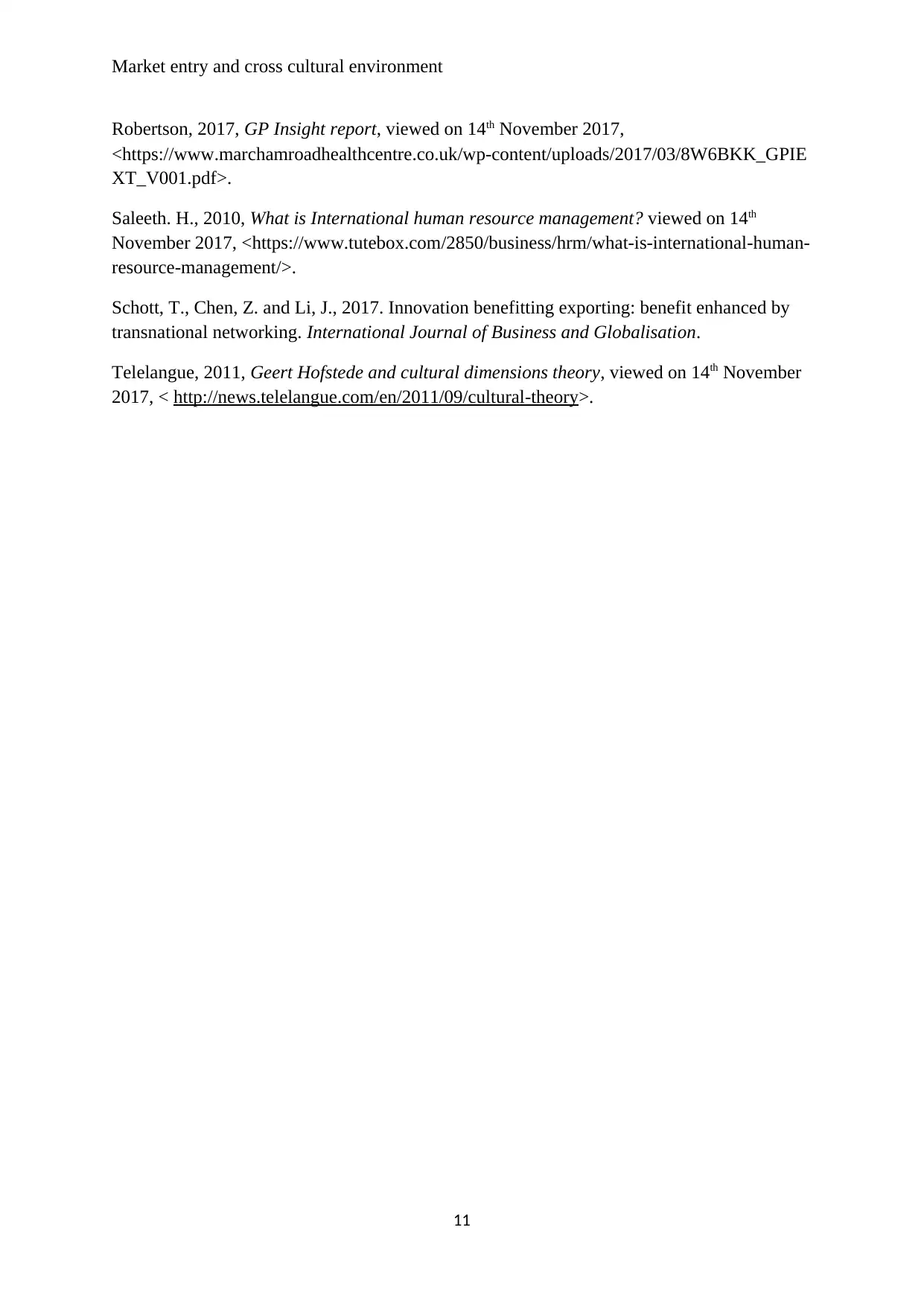
Market entry and cross cultural environment
Robertson, 2017, GP Insight report, viewed on 14th November 2017,
<https://www.marchamroadhealthcentre.co.uk/wp-content/uploads/2017/03/8W6BKK_GPIE
XT_V001.pdf>.
Saleeth. H., 2010, What is International human resource management? viewed on 14th
November 2017, <https://www.tutebox.com/2850/business/hrm/what-is-international-human-
resource-management/>.
Schott, T., Chen, Z. and Li, J., 2017. Innovation benefitting exporting: benefit enhanced by
transnational networking. International Journal of Business and Globalisation.
Telelangue, 2011, Geert Hofstede and cultural dimensions theory, viewed on 14th November
2017, < http://news.telelangue.com/en/2011/09/cultural-theory>.
11
Robertson, 2017, GP Insight report, viewed on 14th November 2017,
<https://www.marchamroadhealthcentre.co.uk/wp-content/uploads/2017/03/8W6BKK_GPIE
XT_V001.pdf>.
Saleeth. H., 2010, What is International human resource management? viewed on 14th
November 2017, <https://www.tutebox.com/2850/business/hrm/what-is-international-human-
resource-management/>.
Schott, T., Chen, Z. and Li, J., 2017. Innovation benefitting exporting: benefit enhanced by
transnational networking. International Journal of Business and Globalisation.
Telelangue, 2011, Geert Hofstede and cultural dimensions theory, viewed on 14th November
2017, < http://news.telelangue.com/en/2011/09/cultural-theory>.
11
⊘ This is a preview!⊘
Do you want full access?
Subscribe today to unlock all pages.

Trusted by 1+ million students worldwide
1 out of 12
Related Documents
Your All-in-One AI-Powered Toolkit for Academic Success.
+13062052269
info@desklib.com
Available 24*7 on WhatsApp / Email
![[object Object]](/_next/static/media/star-bottom.7253800d.svg)
Unlock your academic potential
Copyright © 2020–2025 A2Z Services. All Rights Reserved. Developed and managed by ZUCOL.





